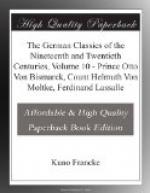One can be truly thankful if one rides a strange horse without causing or experiencing some disaster. A bad rider comes up from behind; a horse sets himself in your way; here a mare kicks up behind; there a stallion kicks up in front. It is but a small affair to ride alone, but in the confusion of such a train, in a short trot on a lively beast, one must keep one’s eyes open. Suddenly the Emperor stops, and there is a general halt; or he turns to one side, and then there is great confusion; he gallops forward, and all plunge after him, while the head of the column has again taken a short movement. With all this the flags are flying, the trumpets are blowing, the drums are beating, and there are endless hurrahs. But one must also see something. I rode a little black horse that I would like to possess; he goes like an East Prussian, but is very spirited, and I constantly found myself in the front among the grand dukes. But I shall get on well with him when we know each other better. He needs a quiet rider with a firm seat, and a light hand on the reins.
This evening at sunset, I again ascended the Kremlin. "Diem perdidi" I should say of the day of my sojourn there in which I did not visit this wonderful structure.
I descended to the Moskwa, and, from under the fine quay, examined the massive white walls, the towers and the gate forts which surround the Czar’s palace, and a whole town of churches of the strangest structure. Tonight the city gives a grand entertainment, from which I shall absent myself to write. One receives so many impressions that it is impossible to digest them all and collect one’s thoughts.
I am trying to understand this architecture. In Culm, in West Prussia, I saw last year in the marketplace such a curious City Hall that I could not reconcile it in my mind; now I understand that it is Moscovite architecture. The Knights of the Sword of Liefland were in intimate connection with the German Knights in Prussia, and one of their architects may have repeated on the Vistula what he had seen on the Moskwa.
The fountains here remind one of the East; little, round covered houses on the principal squares, which are constantly surrounded by men and beasts supplying themselves with water. At first they seem rude and awkward when compared with the fine style, the rich sculpture, the golden railings, and the perforated marble walls of the Tschesmas of Constantinople. There are here, as in the mosques, swarms of doves that are so bold that they scarcely leave room for carriages and foot-passengers. They are often chased out of the shops like a brood of chickens, and they go everywhere for food. No one does them any harm, and the Russians think it a sin to eat them. The Gostinoy Dwor (the merchants’ court) is especially a repetition of the Oriental Tschurchi. One booth is next to the other, and the narrow passages that separate them are covered; therefore the same dim light and the same smell of leather and spices exist as at the Missir, or Egyptian market, in Constantinople. The wares here, however, are mostly European, and cheaper at home, so that we are not much tempted to buy.




